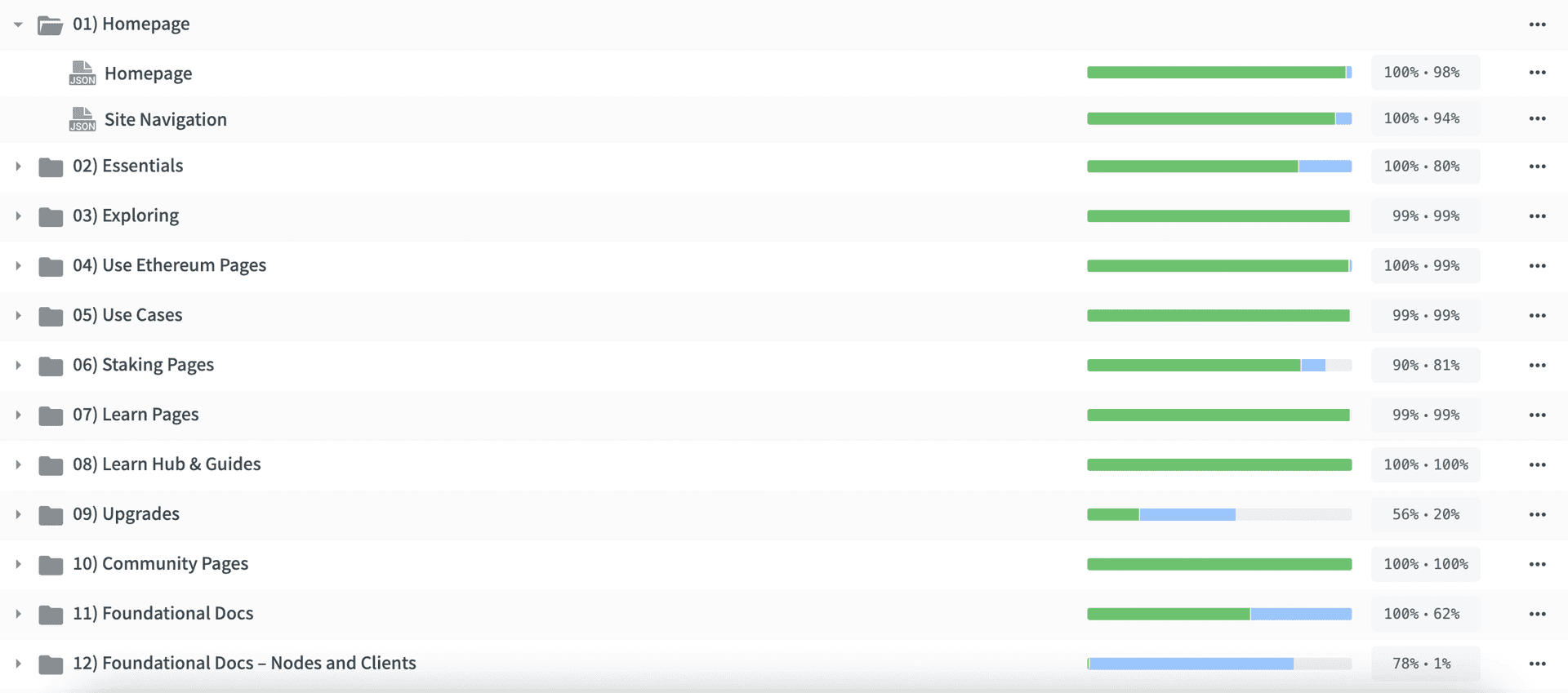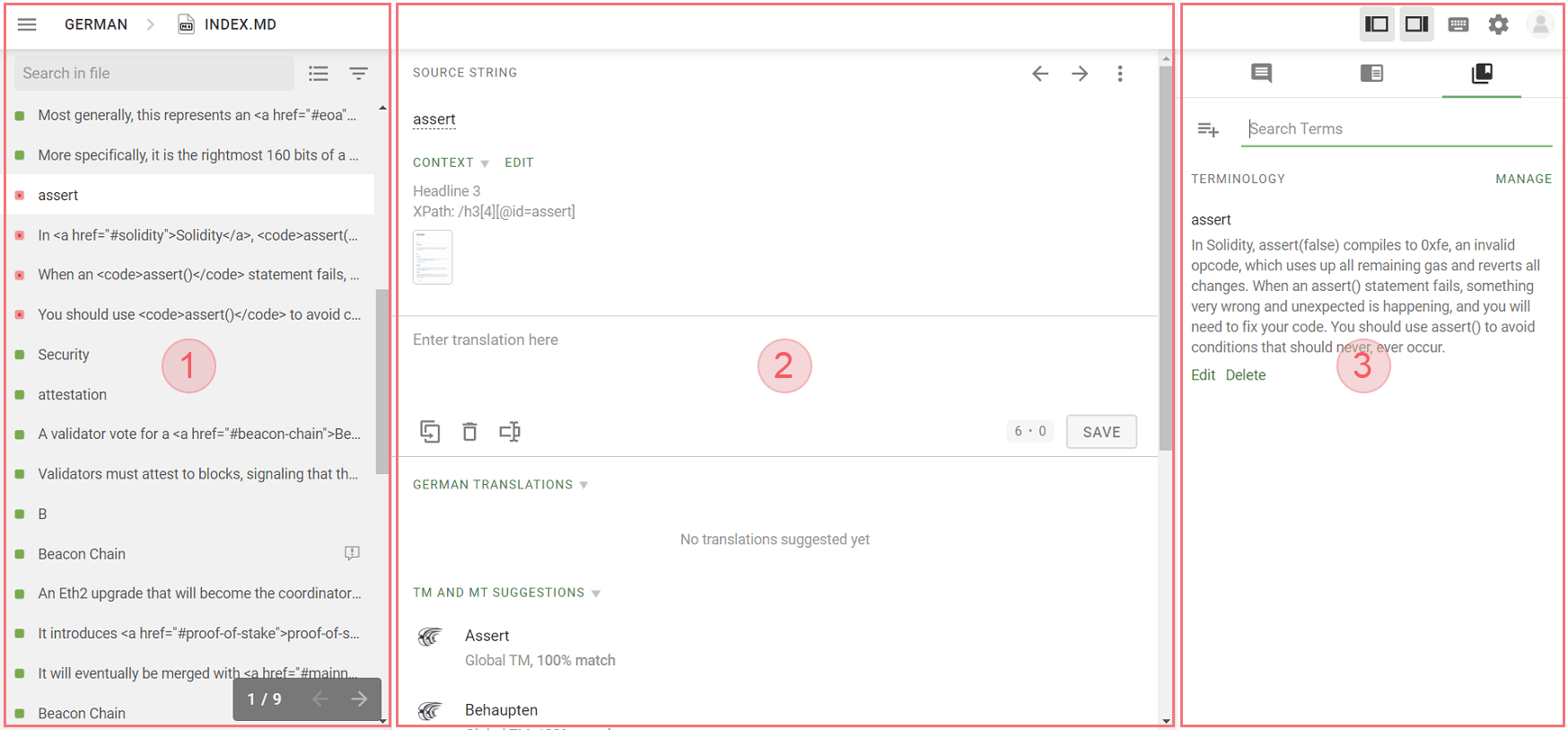Prevajalski program
Prevajalski program je skupno prizadevanje za prevod ethereum.org v različne jezike, z namenom narediti stran bolj dostopno milijardam neangleško govorečih ljudi po svetu.
Naš napredek do zdaj:
- 2.000 + prevajalcev
- 37 jezikov aktivnih na strani
- 1,9 milijona besed prevedenih v 2021
Če se želite pridružiti in nam pomagati povečati globalno Ethereum skupnost s prevajanjem spletne strani v vaš jezik, sledite spodnjim korakom!
Misija in vizija
Ethereum skupnost želi biti globalna in vključevalna, vendar veliko njene vsebine poskrbi le za angleško govoreče in izpušča 6 milijard neangleško govorečih po celem svetu. Da bi ethereum.org lahko deloval kot portal v Ethereum za svetovno skupnost verjamemo, da je zagotavljanje Ethereum vsebin za neangleško govoreče v njihovih domačih jezikih ključnega pomena.
Ethereum.org prevajalski program želi narediti Ethereum dostopen za vse, s prevajanjem strani ethereum.org in ostalih Ethereum vsebin v čim več jezikov.
Naša misija
- Prispevanje prevedenih verzij spletne strani, da opolnomočimo obiskovalce iz vsega sveta za učenje o Ethereumu v njihovem domačem jeziku
- Olajšanje uvajanja več članov v globalno Ethereum skupnost
- Omogočanje bolj dostopnega in vključujočega deljenje informacij in znanja o Ethereumu
- Opolnomočenje članov skupnosti, da prispevajo prevode k Ethereumu in pustijo svoj pečat na ekosistemu
- Prepoznavanje, povezovanje in prispevanje vodenja strastnim sodelavcem, ki se želijo pridružiti ekosistemu
Naša vizija
- Prevod ključnih vsebin za člane Ethereum skupnosti iz čim več držav in delov sveta
- Podpora deljenja znanja prek jezikov za ustvarjanje bolj informirane in izobražene Ethereum skupnosti
- Povečanje Ethereumove vključljivosti in dostopnosti z odstranitvijo jezikovnih ovir, ki preprečujejo neangleško govorečim pridružitev ekosistemu
Kako prevajate?
-
Pridružite se našemu projektu na Crowdinu
Morali se boste prijaviti v vaš Crowdin račun ali ga ustvariti, če ga še nimate. Vse kar je potrebno za prijavo, je le e-poštni naslov in geslo. -
Odprite jezik, ki ga želite prevajati in poiščite dokument za delo
Vsebina spletne strani je razdeljena v številne dokumente in jezikovne verzije. Na desni lahko preverite napredek vsakega dokumenta – če je napredek prevoda pod 100 % prosimo prispevajte!Ne najdete svojega jezika na seznamu? Odprite težavo
Opomba na vsebinske verzije: uporabljamo upravljanje verzij z Crowdinom, da se izognemo prevajalskim zamudam za dodane vsebine. Ko preverite jezik, na primer Filipinščino, boste našli mape za vsako verzijo strani ("v2.0", "v2.1", etc.).
Spodbujamo vas, da najprej prevajate nižjo verzijo in se prebijate proti višjim verzijam (v.2.0 → v.2.1 → v.2.2 → ⋯), saj bodo nižje verzije na strani posodobljene najprej.
-
Prevajanje
Po izbiri datoteke, ki jo želite prevesti, se bo ta odprla v spletnem urejevalniku. Če niste še nikoli uporabljali Crowdina, lahko uporabite ta hitri vodnik, da pregledate osnove.1 – Leva stranska vrstica
- Neprevedeno (rdeča) – besedilo, na katerem se še ni delalo. To so nizi, ki bi jih morali prevajati.
- Prevedeno (zelena) – besedilo, ki je že bilo prevedeno, vendar še ne pregledano. Lahko podate alternativne predloge prevodov ali glasujete o obstoječih z uporabo ‘’+’’ in ‘’-‘‘ gumbov v urejevalniku.
- Potrjeno (kljukica) – besedilo je že bilo pregledano in je trenutno dostopno na spletni strani.
Prav tako lahko uporabljate gumbe na vrhu, za iskanje določenih nizov, jih filtrirate glede na status ali spremenite pogled.
2 – Območje urejevalnika
Glavno prevajalsko območje – izvorno besedilo je prikazano na vrhu z dodatnim kontekstom in posnetki zaslonov, če so na voljo. Za predlog novega prevoda, vnesite svoj prevod v polje "Vnesite prevod tukaj" in pritisnite Shrani.
Prav tako lahko v tej sekciji najdete obstoječe prevode nizov in prevode v ostale jezike, kot tudi ujemanja z pomnilnikom prevodov in predloge strojnega prevoda.
3 – Desna stranska vrstica
Tukaj lahko najdete komentarje, vnose v pomnilnik prevodov in vnose v slovar. Privzeti pogled prikazuje komentarje in prevajalcem omogoča komunikacijo, izpostavljanje težav ali prijavo nepravilnih prevodov.
Z gumbi na vrhu lahko prikaz zamenjate na pomnilnik prevodov, kjer lahko iščete obstoječe prevode, ali slovar, ki vsebuje opise in standardizirane prevode ključnih izrazov.
Si želite izvedeti več? Prosto si oglejte dokumentacijo o uporabi Crowdinovega spletnega urejevalnika
-
Preces pregleda
Ko ste zaključili prevod (torej vse datoteke vsebinskih verzij prikazujejo 100%), bo naša strokovna prevajalska pomoč pregledala (in po potrebi uredila) vsebino. Ko je pregled zaključen (torej proces pregleda je 100%), bomo vsebino dodali na spletno stran.
Imate kakšno vprašanje? Ali želite sodelovati z našo ekipo in ostalimi prevajalci? Objavite v kanal #translations našega ethereum.org Discord strežnika
Prav tako nas lahko kontaktirate prek translations@ethereum.org
Hvala za vaše sodelovanje pri ethereum.org prevajalskem programu!
Viri
Orodja
- Linguee_ – iskalnik za prevode in slovar, ki omogoča iskanje po besedah ali frazah_
- Proz term search_ – podatkovna baza prevajalskih slovarjev za specializirane izraze_
- Eurotermbank_ – zbirke evropske terminologije v 42-ih jezikih_
Skupnosti
- Prevajalske skupine za posamezne jezike – iniciativa za povezovanje ethereum.org prevajalcev v prevajalske skupine
- Kitajska prevajalska skupina_ – Stran s pojmi za lažjo koordinacijo med kitajskimi prevajalci_
Pregled verzij
- Vsebinske verzije_ – Katere strani so vključene v vsako verzijo strani ethereum.org_
Zadnje spremembe
Da boste na tekočem z napredkom prevajalskega programa, sledite blogu Ethereum fundacije:
- December 2020 posodobitev mejnikov
- Julij 2020 posodobitev mejnikov
- Avgust 2019 zagon prevajalskega programa
Prevajanje Ethereum Launchpada za zastavljanje
Naša prevajalska skupnost prav tako dela na Launchpad za zastavljanje. Ta je v pomoč vsem, ki želijo nastaviti Ethereum validator in pomagati pri zavarovanju Ethereum omrežja. Launchpad je trenutno na voljo v 17 jezikih.
Če ste zainteresirani, se pridružite prevajalskemu projektu Ethereum Launchpad za zastavljanje na Crowdinu. Lahko ustvarite težavo na GitHubu, da zaprosite dodajanje novega jezika, če vaš jezik na Crowdinu še ni na voljo.

